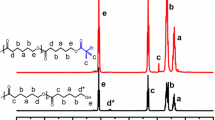Abstract
A series of amphiphilic hyperbranched poly (amine-ester)-poly (lactide-co-glycolide) (HPAE-co-PLGA) copolymers were synthesized by ring-opening polymerization of dl-lactide, glycolide and a fourth generation hyperbranched poly (amine-ester) (HPAE-OHs4) with Sn(Oct)2 as catalyst. The chemical structure of copolymers was characterized by Fourier transform infrared (FT-IR), nuclear magnetic resonance (1H-NMR, 13C-NMR), thermo gravimetric analysis apparatus (TGA), and different scanning calorimetry (DSC). Formation and characteristics of polymeric micelles of the amphiphilic copolymer were studied by environmental scanning electron microscopy (ESEM), fluorescence spectroscopy, and dynamic light scattering (DLS). In order to estimate the feasibility as novel drug carriers, a lipophilic model drug amphotericin B was incorporated into polymeric micelles and the drug release behavior was investigated. The micelle size and drug-loading content were found increased, and the drug-release rate decreased with the increase of molar ratio of dl-lactide/glycolide to HPAE.









Similar content being viewed by others
References
Hans M, Shimoni K, Danino D, Siegel SJ, Lowman A (2005) Synthesis and characterization of mPEG-PLA prodrug micelles. Biomacromolecules 6:2708–2717
Lin R, Ng LS, Wang CH (2005) In vitro study of anticancer drug doxorubicin in PLGA-based microparticles. Biomaterials 26:4476–4485
Wang C, Wang C, Hsiue GH (2005) Polymeric micelles with a pH-responsive structure as intracellular drug carriers. J Control Release 108:140–149
Agrawal SK, Sanabria-DeLong N, Coburn JM, Tew GN, Bhatia SR (2006) Novel drug release profiles from micellar solutions of PLA–PEO–PLA triblock copolymers. J Control Release 112:64–71
Jiang XZ, Zhang JY, Zhou YM, Xu J, Liu SY (2008) Facile preparation of core-crosslinked micelles from azide-containing thermoresponsive double hydrophilic diblock copolymer via click chemistry. J Polym Sci A Polym Chem 46:860–871
Riess G (2003) Micellization of block copolymers. Prog Polym Sci 28:1107–1170
Ryu JG, Jeong YI, Kim IS, Lee JH, Nah JW, Kim SH (2000) Clonazepam release from core–shell type nanoparticles of poly(ε-caprolactone)/poly(ethylene glycol)/poly(ε-caprolactone) triblock copolymers. Int J Pharm 200:231–242
Lo CL, Huang CK, Lin KM, Hsiue GH (2007) Mixed micelles formed from graft and diblock copolymers for application in intracellular drug delivery. Biomaterials 28:1225–1235
Han HD, Shin BC, Choi HS (2006) Doxorubicin-encapsulated thermosensitive liposomes modified with poly (N-isopropylacrylamide-co-acrylamide): drug release behavior and stability in the presence of serum. Eur J Pharm Biopharm 62:110–116
Yoo HS, Park TG (2001) Biodegradable polymeric micelles composed of doxorubicin conjugated PLGA–PEG block copolymer. J Control Release 70:63–70
Layre A, Couvreur P, Chacun H, Richard J, Passirani C, Requier D, Benoit JP, Gref R (2006) Novel composite core–shell nanoparticles as busulfan carriers. J Control Release 111:271–280
Li YY, Zhang XZ, Kim GC, Cheng H, Cheng SX, Zhuo RX (2006) Thermosensitive Y-shaped micelles of poly(oleic acid-Y-N-isopropylacrylamide) for drug delivery. Small 2:917–923
Gao C, Yan D (2004) Hyperbranched polymers: from synthesis to applications. Prog Polym Sci 29:183–275
Voit B (2000) New developments in hyperbranched polymers. J Polym Sci A Polym Chem 38:2505–2525
Tian HY, Deng C, Lin H, Sun JR, Deng MX, Chen XS, Jing XB (2005) Biodegradable cationic PEG-PEI-PBLG hyperbranched block copolymer: synthesis and micelle characterization. Biomaterials 26:4209–4217
Rajesh KK, Muthiah G, Munia G, Tanay G, Donald EB, Souvik M, Jayachandran NK (2006) Blood compatibility of novel water soluble hyperbranched polyglycerol-based multivalent cationic polymers and their interaction with DNA. Biomaterials 27:5377–5390
Karger-Kocsis J, Fröhlich J, Gryshchuk O, Kautz H, Frey H, Mülhaupt R (2004) Synthesis of reactive hyperbranched and star-like polyethers and their use for toughening of vinylester-urethane hybrid resins. Polymer 45:1185–1195
Gao C, Xu Y, Yan D, Chen W (2003) Water-soluble degradable hyperbranched polyesters: novel candidates for drug delivery? Biomacromolecules 4:704–712
Kolhe P, Misra E, Kannan RM, Kannan S, Lieh-Lai M (2003) Drug complexation, in vitro release and cellular entry of dendrimers and hyperbranched polymers. Int J Pharm 259:143–160
Kim HJ, Kwon MS, Choi JS, Kim BH, Yoon JK, Kim K, Park JS (2007) Synthesis and characterization of poly (amino ester) for slow biodegradable gene delivery vector. Bioorg Med Chem 15:1708–1715
Jeong B, Bae YH, Kim SW (2000) Drug release from biodegradable injectable thermosensitive hydrogel of PEG-PLGA-PEG triblock copolymers. J Control Release 63:155–163
Blanco MD, Alonso MJ (1997) Development and characterization of protein-loaded poly (lactide-co-glycolide) nanospheres. Eur J Pharm Biopharm 43:287–294
Yang R, Yang SG, Shim WS, Cui F, Cheng G, Kim IW, Kim DD, Chung SJ, Shim CK (2009) Lung-specific delivery of paclitaxel by chitosan-modified PLGA nanoparticles via transient formation of microaggregates. J Pharm Sci 98:970–984
Thomas PA (1994) Mycotic keratitis-an underestimated mycosis. J Med Vet Mycol 32:235–256
Essman TF, Flynn HW Jr, Smiddy WE, Brod RD, Murray TG, Davis JL, Rubsamen PE (1997) Treatment outcomes in a 10-year study of endogenous fungal endophthalmitis. Ophthalmic Surg Lasers 28:185–194
Zhu BK, Wei XZ, Xiao L, Xu YY, Geckeler KE (2006) Preparation and properties of hyperbranched poly (amine-ester) films using acetal cross-linking units. Polym Int 55:63–70
Dong YC, Feng SS (2004) Methoxy poly(ethylene glycol)-poly(lactide) (MPEG-PLA) nanoparticles for controlled delivery of anticancer drugs. Biomaterials 25:2843–2849
Lu Y, Lin D, Wei HY, Shi WF (2001) Synthesis and characterization of hyperbranched poly(amine-ester). Acta Polymer Sin 4:411–414
Karayannidis GP, Roupakias CP, Bikiaris DN, Achilias DS (2003) Study of various catalysts in the synthesis of poly (propylene terephthalate) and mathematical modeling of the esterification reaction. Polymer 44:931–942
Zhang LM (2001) Cellulosic associative thickeners. Carbohydr Polym 45:1–10
Shin IG, Kim SY, Lee YM, Cho CS, Sung YK (1998) Methoxy poly(ethylene glycol)/ε-caprolactone amphiphilic block copolymeric micelle containing indomethacin. I. Preparation and characterization. J Control Release 51:1–11
Niwa T, Takeuchi H, Hino T, Kunou N, Kawashima Y (1993) Preparations of biodegradable nanospheres of water-soluble and insoluble drugs with d, l-lactide/glycolide copolymer by a novel spontaneous emulsification solvent diffusion method, and the drug release behavior. J Control Release 25:89–98
Acknowledgment
This project was supported by the major program for fundamental research of the Chinese Academy of Sciences, China (No: KJCX2-YW-M02); the State Key Development Program for Basic Research of China (973) (No: 2009CB930200).)
Author information
Authors and Affiliations
Corresponding author
Rights and permissions
About this article
Cite this article
Wang, T., Wu, Y. & Li, M. Novel hyperbranched poly (amine-ester)-poly (lactide-co-glycolide) polymeric micelles as amphotericin B carriers. Polym. Bull. 65, 425–442 (2010). https://doi.org/10.1007/s00289-009-0218-9
Received:
Revised:
Accepted:
Published:
Issue Date:
DOI: https://doi.org/10.1007/s00289-009-0218-9




